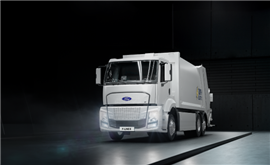Read this article in 中文 Français Deutsch Italiano Português Español
Ford unveils F-Line E battery-electric heavy-duty truck
27 November 2025
 Ford F-Line E (Photo: Ford Trucks)
Ford F-Line E (Photo: Ford Trucks)
While Ford has released a series of battery-electric commercial vehicles, including the Transit E van and F150 Lightning pickup, the OEM has been slow to launch a heavy truck to compete with such models as the D E-Tech from Renault Trucks.
But wait no more - after a series of teaser events, Ford has now premiered its new F-Line E battery-electric model, the company’s first all-electric heavy truck.
The F-Line E is to be offered as 4x2 and 6x2 variants. The former has a curb weight of 7.9 tonnes and GVW of 19 tonnes. Numbers for the latter are 9.3 and 27 tonnes. Both have a max rear axle weight of 11.5 tonnes.
Suspension for each variant consists of a parabolic leaf setup up at the front and an air suspension system at the rear. Rear axle steering is offered on 6x2 versions.
The model is powered by a central Dual eDrive motor positioned between the chassis rails. A three-speed transmission delivers power to the wheels.
The drive in the F-Line E 4x2 features a 294 kW of battery storage (235 kWh usable) which can deliver 235 kW continuous and 290 kW peak power.
The additional axle in the F-Line E 6x2 requires 392 kW of battery storage (314 kWh usable) which can deliver 310 kW continuous and 390 kW peak power.
Both versions use NMC (nickel manganese cobalt) battery cells which support a CCS2 DC charge of up to 213 kW (265 A) and 285 kW (350 A). These deliver a recharging time of less than 50 minutes from 20 to 80% capacity for either size capacity. Range is estimated at 250 km, although this is dependent on various factors, including load weight, road conditions and driving style.
The vehicle has a two-year warranty, while the battery packs are warrantied for eight years or 400,000 km. Warranty periods are limited by total energy throughput of 570 MWh for 4x2 vehicles and 760 MWh for 6x2 versions.
Battery packs, which are located on either side of the central chassis assembly, also support a dedicated electric power take off function which delivers 80 kW continuous and 100 kW peak power.
While the F-Line E was presented with a box assembly, the chassis cab variants are likely to support a range of applications. Marketing materials show the model equipped as a refuse collection vehicle.
Ford puts forward that the F-Line E can lower energy consumption costs, while also saving on routine maintenance such oils and filter changes. This should help to reduce the total cost of ownership. Further, fewer moving parts mean less vibration and a quieter, more comfortable driver experience.
To help with deciding if the F-Line E is suitable for a given application, Ford has created an eConsultation page. Click here to access this link.
POWER SOURCING GUIDE
The trusted reference and buyer’s guide for 83 years
The original “desktop search engine,” guiding nearly 10,000 users in more than 90 countries it is the primary reference for specifications and details on all the components that go into engine systems.
Visit Now
STAY CONNECTED




Receive the information you need when you need it through our world-leading magazines, newsletters and daily briefings.
CONNECT WITH THE TEAM













